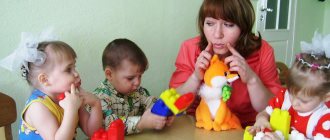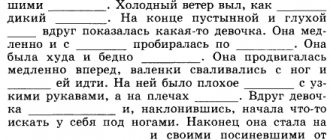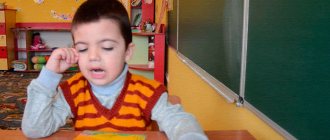Article:
Not in all cases the processes of speech development proceed successfully. In some children, the formation of all components of language is sharply delayed. This violation was first established by R.E. Levina and is defined as a general underdevelopment of speech. General speech underdevelopment (GSD) refers to severe disorders of speech function, which requires special speech therapy to overcome. At the same time, children with normal physiological hearing and an initially preserved intellectual sphere experience late speech development, a poor vocabulary, the presence of agrammatisms, immature phonemic processes, and polymorphic sound pronunciation disorders. These signs indicate a systemic disorder of all components of the child’s speech activity.
Symptoms
R.E. Levina tried to reduce the variety of speech retardation to three levels. Each level is determined by the specificity of the primary defect in relation to secondary disorders that slow down the formation of the speech system. The transition to the next level is characterized by the emergence of more progressive speech capabilities.
The classification of OHP levels and their characteristics are presented in the diagram:
OHP levels (according to Levina R.E.)
Level 1
Speech in children with ODD of the first level of speech development has the following distinctive features: an almost total absence of verbal means of communication or their extremely limited development. Preschoolers of the first level have a vocabulary consisting of a small number of poorly pronounced words of everyday meaning. Words and their onomatopoeic substitutes are used to designate certain objects and verbalize actions. In the process of communication, children actively use facial expressions and gesticulate excessively. There are no morphological elements in speech that convey grammatical relationships. The child’s statements are understandable only to those close to him and only in specific conditions.
Level 2
When describing the second level of speech development, R. E. Levina notes the absence of speech passivity and the appearance of phrasal speech in children. At this level, deficiencies in the phonetic-phonemic system of the language and various grammatical violations remain. The vocabulary is more expanded, but is characterized by a lag behind the norm in terms of qualitative and quantitative indicators.
In independent phrasal speech you can find various parts of speech. Children are able to answer questions according to a given pattern about the family, elementary phenomena of the world, but the active dictionary does not contain words denoting animals and their offspring, individual parts of the body, items of clothing, furniture, and dishes. Generalizing concepts are not used by children. The statements of preschoolers at this level contain multiple agrammatisms. Understanding of addressed speech remains fragmented, since the vocabulary is insufficient and grammatical forms are poorly differentiated.
Level 3
Speech in children with third-level ODD is characterized by the appearance of expanded everyday vocabulary with some grammatical and phonetic deviations. At this level there is uncertain knowledge and incorrect use of many concepts. An incomplete understanding of the grammatical forms of the language remains. The active vocabulary is dominated by nouns and verbs; there are not enough words that define the quality of objects and phenomena, the state of objects; the skill of selecting words with the same root and antonyms suffers. The grammatical structure is characterized by errors in the use of simple and complex prepositions, word formation, inflection, and construction of prepositional-case constructions.
Distortions of the sound-syllable structure of words are observed. The formation of a coherent speech utterance is characterized by a violation of the logic and sequence of presentation. At the same time, the messages reveal the external side of the phenomena and do not take into account their essential features and cause-and-effect relationships. Children find it difficult to update their existing vocabulary and structure their statements.
Level 4
The joint work of scientists made it possible to identify level 4 of OHP, which is presented in detail in the manual by T.B. Filicheva “Features of speech formation in preschool children.”
Gaps in development are weakly expressed and are eliminated in a short period of time. However, if a child does not receive specialist help, speech impairment adversely affects his intelligence, which may cause poor performance in school.
www.Logopedy.ru
With normal speech development, children by the age of 5 freely use expanded phrasal speech and various constructions of complex sentences. They have a sufficient vocabulary and master the skills of word formation and inflection. By this time, correct sound pronunciation and readiness for sound analysis and synthesis are finally formed.
However, not in all cases these processes proceed well: in some children, even with normal hearing and intelligence, the formation of each of the components of the language is sharply delayed: phonetics, vocabulary, grammar. This violation was first established by R.E. Levina and is defined as a general underdevelopment of speech.
All children with general speech underdevelopment always have a violation of sound pronunciation, underdevelopment of phonemic hearing, and a pronounced lag in the formation of vocabulary and grammatical structure.
General speech underdevelopment can manifest itself to varying degrees. Therefore, there are three levels of speech development.
I of speech development is characterized by the absence of speech (the so-called “speechless children”).
Children at this level use mainly babbling words, onomatopoeia, individual nouns and verbs of everyday content, and fragments of babbling sentences, the sound design of which is blurry, unclear and extremely unstable, to communicate. Often the child reinforces his “statements” with facial expressions and gestures. A similar state of speech can be observed in mentally retarded children. However, children with primary speech underdevelopment have a number of features that allow them to be distinguished from oligophrenic children (mentally retarded children). This primarily refers to the volume of the so-called passive vocabulary, which significantly exceeds the active one. In mentally retarded children, no such difference is observed. Further, in contrast to oligophrenic children, children with general speech underdevelopment use differentiated gestures and expressive facial expressions to express their thoughts. They are characterized, on the one hand, by great initiative in speech search in the communication process, and on the other hand, by sufficient criticality of their speech.
Thus, despite the similarity of the speech state, the prognosis for speech compensation and intellectual development in these children is ambiguous.
A significant limitation of the active vocabulary is manifested in the fact that the child uses the same babbling word or sound combination to designate several different concepts (“bibi” - airplane, dump truck, steamship; “bobo” - hurts, lubricate, give an injection). There is also a replacement of the names of actions with the names of objects and vice versa (“adas” - pencil, draw, write; “tui” - sit, chair).
The use of one-word sentences is typical. As N.S. Zhukova notes, the period of a one-word sentence, a sentence made from amorphous root words, can also be observed during normal speech development of the child. However, it is dominant only for 5-6 months and includes a small number of words. In case of severe underdevelopment of speech, this period is delayed for a long time. Children with normal speech development begin early to use grammatical connections of words (“give kheba” - give bread), which can coexist with formless constructions, gradually displacing them. In children with general speech underdevelopment, there is an expansion of the sentence volume to 2-4 words, but at the same time the syntactic constructions remain completely incorrectly formed (“Matik tide thuya” - The boy is sitting on a chair). These phenomena are never observed during normal speech development.
Low speech abilities of children are accompanied by poor life experience and insufficiently differentiated ideas about the surrounding life (especially in the field of natural phenomena).
There is instability in the pronunciation of sounds and their diffuseness. In children's speech, 1-2 syllable words predominate. When trying to reproduce a more complex syllable structure, the number of syllables is reduced to 2 - 3 (“avat” - crib, “amida” - pyramid, “tika” - electric train). Phonemic perception is grossly impaired, difficulties arise even when selecting words that are similar in name but different in meaning (hammer - milk, digs - rolls - bathes). Tasks on the sound analysis of words are incomprehensible to children of this level.
Do you like the article? Tell your friends!
The transition to the second level of speech development (the beginnings of common speech) is marked by the fact that, in addition to gestures and babbling words, although distorted, but fairly constant common words appear (“Alyazai. Alyazai children kill. Kaputn, lidome, lyabaka. Litya give the earth.” - Harvest. Children harvesting crops. Cabbages, tomatoes, apples. Leaves falling to the ground).
At the same time, a distinction is made between some grammatical forms. However, this occurs only in relation to words with stressed endings (table - tables; whines - sing) and relating only to some grammatical categories. This process is still quite unstable, and gross underdevelopment of speech in these children is quite pronounced.
Children's statements are usually poor; the child is limited to listing directly perceived objects and actions.
The story based on the picture and the questions is built primitively, on short, although grammatically more correct, phrases than for children of the first level. At the same time, insufficient development of the grammatical structure of speech is easily detected when the speech material becomes more complex or when the need arises to use words and phrases that the child rarely uses in everyday life.
The forms of number, gender and case for such children essentially do not have a meaningful function. The word change is random in nature, and therefore many different errors are made when using it (“I’m playing mint” - I’m playing with a ball).
Words are often used in a narrow sense, the level of verbal generalization is very low. The same word can be used to name many objects that are similar in shape, purpose or other characteristics (ant, fly, spider, beetle - in one situation - one of these words, in another - another; a cup, a glass is denoted by any of these words). The limited vocabulary is confirmed by ignorance of many words denoting parts of an object (branches, trunk, roots of a tree), dishes (dish, tray, mug), vehicles (helicopter, motor boat), baby animals (baby squirrel, hedgehog, little fox), etc.
There is a lag in the use of words-attributes of objects denoting shape, color, material. Substitutions of word names often appear due to the commonality of situations (cuts - tears, sharpens - cuts). During a special examination, gross errors in the use of grammatical forms are noted:
1) replacement of case endings (“rolled-gokam” - rides on a slide);
2) errors in the use of number forms and gender of verbs (“Kolya pityala” - Kolya wrote); when changing nouns by numbers (“da pamidka” - two pyramids, “dv kafi” - two cabinets);
3) lack of agreement of adjectives with nouns, numerals with nouns (“asin adas” - red pencil, “asin eta” - red ribbon, “asin aso” - red wheel, “pat kuka” - five dolls, “tinya pato” - blue coat, “tinya cube” - blue cube, “tinya cat” - blue jacket).
Children make many mistakes when using prepositional constructions: often prepositions are omitted altogether, while the noun is used in its original form (“Kadas ladyt aepka” - The pencil lies in the box), prepositions can also be replaced (“The notebook has fallen and thawed” - The notebook fell from the table ).
Conjunctions and particles are rarely used in speech.
The pronunciation capabilities of children lag significantly behind the age norm: there is a violation in the pronunciation of soft and hard sounds, hissing, whistling, sonorant, voiced and voiceless (“tupans” - tulips, “Sina” - Zina, “tyava” - owl, etc. ); gross violations in the transmission of words of different syllabic composition. The most typical reduction in the number of syllables (“teviki” - snowmen).
When reproducing words, the sound content is grossly violated: rearrangements of syllables, sounds, replacement and assimilation of syllables, abbreviations of sounds when consonants coincide (“rotnik” - collar, “tena” - wall, “vimet” - bear) are noted.
An in-depth examination of children makes it easy to identify insufficient phonemic hearing, their unpreparedness to master the skills of sound analysis and synthesis (it is difficult for a child to correctly select a picture with a given sound, determine the position of a sound in a word, etc.). Under the influence of special correctional training, children move to a new - III level of speech development, which allows them to expand their verbal communication with others.
III of speech development is characterized by the presence of extensive phrasal speech with elements of lexico-grammatical and phonetic-phonemic underdevelopment.
Children of this level come into contact with others, but only in the presence of parents (educators) who make appropriate explanations (“Mom went aspak. And then she walked, little girl, there was a call. Then they didn’t beat aspalki. Then they sent me pack.” - I went with my mother to the zoo. And then she went, where is the cage, there is a monkey. Then we weren’t at the zoo. Then we went to the park).
Free communication is extremely difficult. Even those sounds that children can pronounce correctly do not sound clearly enough in their independent speech.
Characteristic is the undifferentiated pronunciation of sounds (mainly whistling, hissing, affricates and sonorants), when one sound simultaneously replaces two or more sounds of a given phonetic group. For example, a child replaces with the sound s', which is not yet clearly pronounced, the sounds s (“syapogi” instead of boots), sh (“syuba” instead of a fur coat), ts (“syaplya” instead of a heron).
At the same time, at this stage, children already use all parts of speech, correctly use simple grammatical forms, try to build complex and complex sentences (“Kola sent a messenger to the forest, washed a little squirrel, and Kolya got a cat in the rear” - Kolya went into the forest, caught a small squirrel, and lived in Kolya’s cage).
The child’s pronunciation abilities improve (it is possible to identify correctly and incorrectly pronounced sounds, the nature of their violation), and the reproduction of words of different syllable structure and sound content. Children usually no longer find it difficult to name objects, actions, signs, qualities and states that are well known to them from life experience. They can freely talk about their family, themselves and comrades, the events of the surrounding life, write a short story (“The cat poshya kueuke. And now she wants to eat sypyatki. They run away. The cat is filthy kuitsa. Sypyatkakh mogo. Shama shtoit. Kuitsa choesha, she dirty cat" - The cat went to the chicken. And now she wants to eat chickens. They run away. The chicken drove the cat away. There are a lot of chickens. She stands on her own. The chicken is good, she drove the cat away).
However, a careful study of the state of all aspects of speech reveals a clear picture of underdevelopment of each of the components of the language system: vocabulary, grammar, phonetics.
In oral communication, children try to “bypass” words and expressions that are difficult for them. But if you put such children in conditions where it turns out to be necessary to use certain words and grammatical categories, gaps in speech development appear quite clearly.
Although children use extensive phrasal speech, they experience greater difficulties in independently composing sentences than their normally speaking peers.
Against the background of correct sentences, one can also find ungrammatical ones, which arise, as a rule, due to errors in coordination and management. These errors are not constant: the same grammatical form or category can be used both correctly and incorrectly in different situations.
Errors are also observed when constructing complex sentences with conjunctions and allied words (“Misha zyapyakal, the atom fell” - Misha cried because he fell). When making sentences based on a picture, children, often correctly naming the character and the action itself, do not include in the sentence the names of the objects used by the character.
Despite the significant quantitative growth of the vocabulary, a special examination of lexical meanings allows us to identify a number of specific shortcomings: complete ignorance of the meanings of a number of words (swamp, lake, stream, loop, straps, elbow, foot, gazebo, veranda, porch, etc.), inaccurate understanding and the use of a number of words (hem - sew up - cut, trim - cut out). Among the lexical errors the following stand out:
a) replacing the name of a part of an object with the name of the whole object (the dial is “watch”, the bottom is “teapot”);
b) replacing the names of professions with names of actions (ballerina - “aunt is dancing”, singer - “uncle is singing”, etc.);
c) replacing specific concepts with generic ones and vice versa (sparrow - “bird”; trees - “Christmas trees”);
d) interchange of characteristics (tall, wide, long - “big”, short - “small”).
In free expressions, children make little use of adjectives and adverbs denoting the characteristics and state of objects and methods of action.
Insufficient practical skill in using word formation methods impoverishes the ways of vocabulary accumulation and does not give the child the opportunity to distinguish the morphological elements of a word.
Many children often make mistakes in word formation. Thus, along with correctly formed words, non-normative ones appear (“stolenok” - table, “lily” - jug, “vaska” - vase). Such errors, as isolated ones, can normally occur in children at earlier stages of speech development and quickly disappear.
A large number of errors occur in the formation of relative adjectives with the meaning of correlation with food, materials, plants, etc. (“fluffy”, “puffy”, “downy” - scarf; “klyukin”, “klyukny”, “klyukonny” - jelly; “steklyashkin”, “glass” - glass, etc.).
Among the errors in grammatical formatting of speech, the most specific are the following:
a) incorrect agreement of adjectives with nouns in gender, number, case (“Books lie on large (large) tables” - Books lie on large tables);
b) incorrect agreement of numerals with nouns (“three bears” - three bears, “five fingers” - five fingers; “two pencils” - two pencils, etc.);
c) errors in the use of prepositions - omissions, substitutions, omissions (“We went to the store with mom and brother” - We went to the store with mom and brother; “The ball fell from the shelf” - The ball fell from the shelf);
d) errors in the use of plural case forms (“In the summer I was in the village with my grandmother. There is a river, a lot of trees, geese”).
The phonetic design of speech in children with level III speech development lags significantly behind the age norm: they continue to exhibit all types of sound pronunciation disorders (sigmatism, rhotacism, lambdacism, voicing and mitigation defects).
There are persistent errors in the sound filling of words, violations of the syllabic structure in the most difficult words (“Gynasts perform in the circus” - Gymnasts perform in the circus; “Topovotik is repairing the water drain” - Vodoprovodchit is repairing the water supply system; “Takiha tet tan” - The weaver is weaving fabric).
Insufficient development of phonemic hearing and perception leads to the fact that children do not independently develop readiness for sound analysis and synthesis of words, which subsequently does not allow them to successfully master literacy at school without the help of a speech therapist.
So, the totality of the listed gaps in the phonetic-phonemic and lexical-grammatical structure of a child’s speech serves as a serious obstacle to his mastering the program of a general kindergarten, and subsequently the program of a comprehensive school.
Filicheva T.B., Cheveleva N.A. Speech disorders in children. – M., 1993.
Other articles on the topic “general speech underdevelopment”:
- Physical development of children with special needs of preschool age
- Development of optical-spatial concepts in preschool children with OHP
- Speech development for children with special needs development using a wooden toy
| If you liked this article, share the link to the article with your friends and acquaintances on social media. networks using this button | If you have your own special opinion about the material presented, leave your comment in the form below |
Social commentary Cackle
Discrimination from similar conditions
Speech disorders are accompanied by disorders of non-speech mental functions and motor skills (general, manual, articulatory). It is difficult for such children to concentrate on educational and didactic material. Behavioral deviations, hyperactive manifestations, and disturbances in the functioning of the autonomic nervous system are also observed.
At first glance, speech in children with ODD is similar to speech in other speech therapy disorders. During the examination, it is important to correctly diagnose similar conditions. The distinctive symptoms of FFNR and ONR are presented in the table.
The diagnostic results are entered into the speech card. The dynamics of correctional work are also noted there.
Corrective work
Correction of speech disorders is carried out using gaming methods and techniques. Developmental speech therapy games are used during diagnosis and in every lesson.
The content of speech therapy work depends on the level of speech development and age of the child. The main directions are the following:
At OHP level 4 of speech development, work is carried out in the following areas:
Comprehensive correction of the defect includes the formation of ideas about space, classes with a defectologist, family psychotherapy, communication games, exercises to activate the cerebral cortex, literacy classes, writing lessons, and the development of mental activity.
Diagnosis of general speech underdevelopment
The OHP examination is identified by a speech therapist while communicating with the child. To identify the degree of the disease, oral speech testing is carried out with an assessment of vocabulary, sound pronunciation and grammar. The specialist asks the child to compose a story based on the picture, retell what he heard, and compose his own story.
Ignoring the signs of ODD can lead to a complete lack of speech and withdrawal of the child due to the inability to establish communication with peers and adults. As a result, difficulties with learning and socialization are possible.










